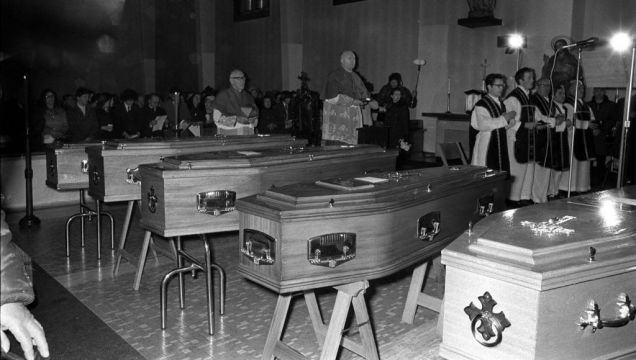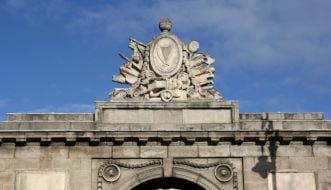The horror of Bloody Sunday unfolded after days of mounting tensions in Derry, Northern Ireland.
A week before the fatal shootings, soldiers had fired plastic bullets and CS gas at protesters at a banned civil rights demonstration on Magilligan Strand near Derry.
Four days later, two Royal Ulster Constabulary officers – Constable David Montgomery, 20, and Sergeant Peter Gilgunn, 26 – were shot dead by republicans in the nationalist Creggan area of the city. The young men were the first policemen killed in Derry during the Troubles.
While the mood in the city was tense when the morning of January 30th 1972 arrived, few could have predicted the bloodshed that followed.
It was just after lunchtime when demonstrators started assembling on the Creggan estate for the latest Northern Ireland Civil Rights Association (Nicra) protest march, an event outlawed by a Stormont ban on large public assemblies and processions.
This time the destination was the city’s Guildhall.
2.50pm
Due to get under way at 2pm, the start is delayed by 50 minutes to accommodate the steady stream of late arrivals.
Marchers leave Creggan Drive and set off for the city centre, with hundreds joining in at almost every turn.
3.25pm
The march passes the Bogside Inn bar and continues on to William Street.
Estimates of the size of demonstration at this point vary. Organisers claimed up to 20,000 people were involved, while the authorities put it at a more conservative 3,000 to 5,000.
3.45pm
With the British Army having erected barricades blocking the way to the Guildhall, the main body of the march turns left on to Rossville Street towards the revised rallying point at the famous Free Derry corner at the entrance to the nationalist Bogside estate.
A number break off and continue down William Street to confront soldiers at a barricade. Some rioting ensues.
Minor clashes between stone-throwers and security forces at this junction were commonplace, with locals dubbing the area “aggro corner”.
3.55pm
Before the main shooting incident, and at a location away from both the riot and march, two soldiers in a derelict building on William Street fire a number of rounds after claiming they had come under attack.
An Official IRA member is believed to have fired at the building during this incident.
Two men are injured when the soldiers opened fire.
One of them, 59-year-old John Johnston, dies four months later.
Campaigners have long acknowledged him as the 14th victim of Bloody Sunday.
However, the Bloody Sunday inquiry said the wounds he sustained on the day did not contribute to his death, noting he had an inoperable brain tumour.
3.56pm
Rioters disperse from William Street after the Army deploys water cannons.
Paratroopers request permission to commence an arrest operation on those who had fled down Chamberlain Street and Rossville Street.
4.07pm
A company of paratroopers, led by Major Ted Loden, is given an order to start arresting any remaining rioters in William Street. But they are told not to engage in a running battle down Rossville Street.
4.10pm
The soldiers open fire on people in the area of Rossville Flats.
Where the victims were shot:
– Car park of Rossville Flats: Jackie Duddy.
– Forecourt on the other side of the flats: Pat Doherty, Barney McGuigan.
– Rubble barricade in Rossville Street beside the flats: Hugh Gilmour, Kevin McElhinney, Michael Kelly, John Young, William Nash and Michael McDaid.
– Glenfada Park on other side of Rossville Street: James Wray, Gerald Donaghey, Gerald McKinney and William McKinney (not related).
4.40pm
The shooting ends.
As well as the 13 fatalities, 15 other people are wounded.
More than 20 soldiers fired in the incident, expending 108 rounds in total.
The British Army claims it came under fire in the Rossville Flats area, allegedly from the Provisional IRA.
Eyewitnesses insist none of the dead were armed.
The 13 victims of Bloody Sunday
– Patrick Doherty, 31
The married father-of-six was shot from behind as he attempted to crawl to safety from the forecourt of Rossville Flats.
– Gerald Donaghey, 17
The IRA youth member was shot in the abdomen while running between Glenfada Park and Abbey Park.
While Lord Mark Saville in his Bloody Sunday inquiry said it was probable that he was in possession of nail bombs when he was shot, he stressed that he was not preparing to throw a nail bomb at the time and was shot “while trying to escape from the soldiers”.
– John ‘Jackie’ Duddy, 17
The first to be killed on Bloody Sunday, the teenager was running away when he was shot in the chest in the car park of Rossville Flats.
– Hugh Gilmour, 17
The talented footballer and ardent Liverpool fan was hit with a single shot as he ran away from the rubble barricade in Rossville Street.
– Michael Kelly, 17
The trainee sewing machine mechanic was shot once in the abdomen close to the rubble barricade in Rossville Street by a soldier crouched some 80 yards away at Kells Walk.
– Michael McDaid, 20
The barman died instantly after being shot in the face at the barricade in Rossville Street.
– Kevin McElhinney, 17
The grocery store worker was shot from behind as he crawled towards Rossville Flats.
– Bernard ‘Barney’ McGuigan, 41
The father-of-six was going to the aid of Patrick Doherty, waving a white handkerchief, when he was shot in the head with a single round. He died instantly.
– Gerard McKinney, 35
The father-of-eight was running close behind Gerald Donaghey in Abbey Park when the bullet that killed both of them hit him first.
– William ‘Willie’ McKinney, 27
The keen amateur film-maker, who was not related to Gerard McKinney, recorded scenes from the march with his hand-held cinecamera before the shooting started.
The camera was found in his jacket pocket as he lay dying after being shot in the back in Glenfada Park.
– William Nash, 19
The dockworker was struck by a single bullet to the chest close to the rubble barricade in Rossville Street.
– James Wray, 22
The civil rights activist, who was engaged to be married, was shot twice in the back in Glenfada Park.
– John Young, 17
The menswear shop clerk was killed instantly with a single shot to the head at the rubble barricade.
– 15 other people were injured
They included 59-year-old John Johnston, who was shot twice by soldiers positioned inside a derelict building in William Street.
He died four months later in hospital, but while many consider him the 14th victim of Bloody Sunday, his death was formally attributed to an inoperable brain tumour.
The soldiers who fired were targeting 15-year-old Damien Donaghy, who was struck in the thigh.
As well as Mr Johnston and Damien, the others injured in the shootings were: Michael Bradley, 22, Michael Bridge, 25, Alana Burke, 18, Patrick Campbell, 51, Margaret Deery, 31, Joseph Friel, 22, Danny Gillespie, 32, Patrick McDaid, 25, Daniel McGowan, 38, Joseph Mahon, 16, Alexander Nash, 51, Patrick O’Donnell, 41, and Michael Quinn, 17.







